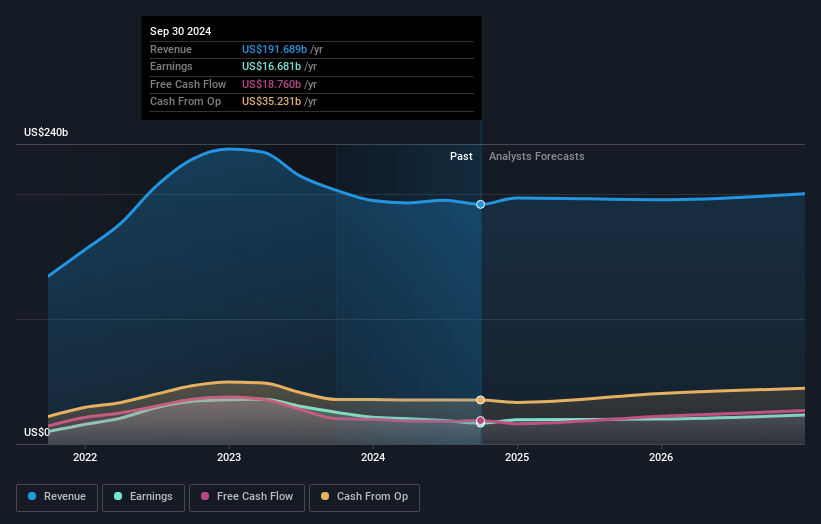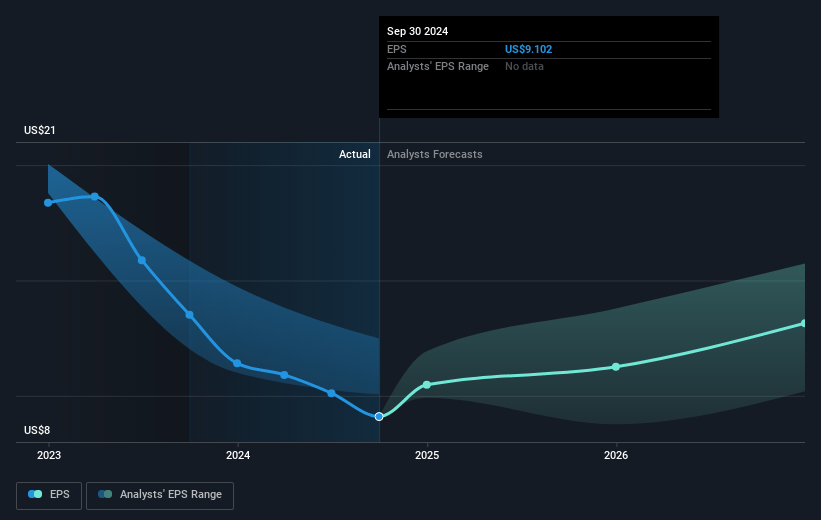Key Takeaways
- Chevron aims for industry-leading cash flow growth by optimizing upstream assets and completing major projects, boosting revenues and cash flow significantly.
- Focus on cost reductions, competitive projects, and renewable energy expansion is expected to enhance efficiency, diversify revenue, and improve shareholder returns.
- Chevron's reliance on asset sales and politically complex regions for production may introduce earnings volatility and impact long-term financial stability.
Catalysts
About Chevron- Through its subsidiaries, engages in the integrated energy and chemicals operations in the United States and internationally.
- Chevron expects to achieve industry-leading free cash flow growth by 2025 and 2026, driven by optimizing advantaged upstream assets and completing major projects such as the Future Growth Project at TCO. This is likely to significantly impact the company's revenues and cash flow.
- The completion and ramp-up of projects in the Gulf of America, including at the Anchor, Whale, and Ballymore fields, along with optimization in the Permian, are expected to augment production levels and improve net margins.
- The firm's commitment to structural cost reductions, targeting $2 billion to $3 billion by 2026 through asset sales and technological advancements, is intended to improve efficiency and bolster net earnings.
- Expansion in renewable energies, particularly in hydrogen and carbon capture, as well as enhancements in the petrochemical sector, will potentially diversify Chevron’s revenue streams and support its long-term strategic growth, likely enhancing overall earnings.
- By maintaining capital discipline and focusing on only the most competitive projects, Chevron aims to sustain its dividend growth and continue significant share buybacks, improving shareholder returns and potentially boosting earnings per share.
Chevron Future Earnings and Revenue Growth
Assumptions
How have these above catalysts been quantified?- Analysts are assuming Chevron's revenue will decrease by 0.4% annually over the next 3 years.
- Analysts assume that profit margins will increase from 9.0% today to 11.7% in 3 years time.
- Analysts expect earnings to reach $22.7 billion (and earnings per share of $13.86) by about March 2028, up from $17.7 billion today. However, there is a considerable amount of disagreement amongst the analysts with the most bullish expecting $28.8 billion in earnings, and the most bearish expecting $17.0 billion.
- In order for the above numbers to justify the analysts price target, the company would need to trade at a PE ratio of 14.7x on those 2028 earnings, down from 16.5x today. This future PE is greater than the current PE for the US Oil and Gas industry at 13.1x.
- Analysts expect the number of shares outstanding to decline by 4.68% per year for the next 3 years.
- To value all of this in today's terms, we will use a discount rate of 7.38%, as per the Simply Wall St company report.
Chevron Future Earnings Per Share Growth
Risks
What could happen that would invalidate this narrative?- Chevron's downstream earnings were notably lower due to softer refining and chemicals margins and timing effects, which could impact overall revenue and net margins if such conditions persist.
- Though Chevron achieved record production, net earnings decreased compared to the previous quarter due to revisions to asset retirement obligations and other timing effects, which might affect future profit and cash flow variability.
- The company's reliance on asset sales and asset retirement obligations for its cash flow improvements could result in short-term boosts that might not be sustainable, potentially influencing revenue consistency and long-term financial stability.
- Despite optimism about free cash flow growth, Chevron's production growth outlook is concentrated on operations in politically complex geographies (e.g., West Africa, Eastern Mediterranean, Venezuela), which adds geopolitical risk potentially impacting future revenue and earnings consistency.
- Foreign currency fluctuations contributed significant gains during the quarter; reliance on such factors can introduce volatility to net profit outcomes, thereby affecting expected earnings predictability.
Valuation
How have all the factors above been brought together to estimate a fair value?- The analysts have a consensus price target of $176.759 for Chevron based on their expectations of its future earnings growth, profit margins and other risk factors. However, there is a degree of disagreement amongst analysts, with the most bullish reporting a price target of $203.0, and the most bearish reporting a price target of just $156.0.
- In order for you to agree with the analyst's consensus, you'd need to believe that by 2028, revenues will be $193.5 billion, earnings will come to $22.7 billion, and it would be trading on a PE ratio of 14.7x, assuming you use a discount rate of 7.4%.
- Given the current share price of $165.94, the analyst price target of $176.76 is 6.1% higher. The relatively low difference between the current share price and the analyst consensus price target indicates that they believe on average, the company is fairly priced.
- We always encourage you to reach your own conclusions though. So sense check these analyst numbers against your own assumptions and expectations based on your understanding of the business and what you believe is probable.
How well do narratives help inform your perspective?
Disclaimer
Warren A.I. is a tool utilizing a Large Language Model (LLM) that ingests data on consensus price targets, forecasted revenue and earnings figures, as well as the transcripts of earnings calls to produce qualitative analysis. The narratives produced by Warren A.I. are general in nature and are based solely on analyst data and publicly-available material published by the respective companies. These scenarios are not indicative of the company's future performance and are exploratory in nature. Simply Wall St has no position in the company(s) mentioned. Simply Wall St may provide the securities issuer or related entities with website advertising services for a fee, on an arm's length basis. These relationships have no impact on the way we conduct our business, the content we host, or how our content is served to users. The price targets and estimates used are consensus data, and do not constitute a recommendation to buy or sell any stock, and they do not take account of your objectives, or your financial situation. Note that Warren A.I.'s analysis may not factor in the latest price-sensitive company announcements or qualitative material.




